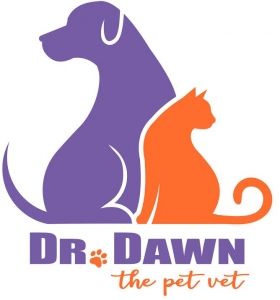 I am often asked about how cats and dogs get along. More often than not, there are few to no problems. Still, at times it can be stressful, particularly if your dog or cat has never spent time with the other species, to introduce a new cat to your dog, or vice-versa. Here are a few things you can to do help ease the introduction and avoid situations that could potentially harm your cat and dog.
I am often asked about how cats and dogs get along. More often than not, there are few to no problems. Still, at times it can be stressful, particularly if your dog or cat has never spent time with the other species, to introduce a new cat to your dog, or vice-versa. Here are a few things you can to do help ease the introduction and avoid situations that could potentially harm your cat and dog.
Keep in mind:
A change in routine behaviors can tell you a lot about a pet. If your cat is not eating or using he litter box properly, or is not interacting with other household members in their usual manner, it is likely that the introduction process is making them unhappy and stressed.
Dogs with high prey drives, or those who tend to chase squirrels and small animals, may prove to be more of a challenge. They may not differentiate between “family” cats and “outside” cats, and could see your cat as potential prey, particularly if the cat starts running away. It is crucial to take your time during all steps of this process. Do not proceed forward until you are comfortable with the results of previous steps.
Tips and tricks to consider before starting the introduction process:
-Simple obedience training for your dog, particularly recall (so that they come when called) and a ‘leave it’command (to redirect attention away from anything that causes agitation). Crate-training is also useful.
-Make sure your cat has safe areas it can retreat to which the dog cannot reach, such as high platform spaces.
-If your dog is highly energetic, spend some time playing with him and burning off that excess energy before each step in the introduction process. He will be less likely to try to engage your cat in over-stimulating play, which the cat may perceive as threatening behavior.
-If a situation arises where you need to quickly separate your dog and cat, do not attempt to grab the cat first. Their first instinct will be to flee, and so it is usually best to restrain your dog rather than your cat.
Step 1: Set up a room where you can house your new pet for the first few days. It is important that they be allowed to adjust to their new environment before they meet any other pets, and that they have a safe space to retreat to if they get too overwhelmed. Gradually, you can start introducing them to different parts of the house, making sure to keep other pets away (and preferably out of sight) while they are exploring. Once they have familiarized themselves with the various scents around the house (including those belonging to other animals), they should be allowed to go back to their safe space so that your other pets can get used to the scent the newcomer left behind.
Step 2: Once both parties are comfortable with having ‘met’ the other through scent and show no signs of agitation, you can start introductions in a controlled environment where both dog and cat have some form of physical separation between them. This can be in the form of a dog crate, baby gate, or toddler playpen. Remember that is should be the dog, and not the cat, who is restrained. Allow the cat to approach the dog at their own pace, so that they can familiarize themselves with their scent and appearance while having the safety of a barrier between them. You can bring along treats to reward both pets for positive behavior when hey do not display aggression or fear. If your dog is barking try to redirect his attention elsewhere (this is where the ‘leave it’ command becomes useful).
 Keep these interactions fairly short, as you don’t want to overwhelm either pet. You can repeat them as many times as necessary over the next few days and increase they interaction time if things are progressing well, until once again both cat and dog show that they are comfortable with the situation.
Keep these interactions fairly short, as you don’t want to overwhelm either pet. You can repeat them as many times as necessary over the next few days and increase they interaction time if things are progressing well, until once again both cat and dog show that they are comfortable with the situation.
Step 3: Once you and your pets are comfortable with their interactions in the previous two steps, you can move up to restraining your dog with a leash and eliminating the separating barrier. The leash acts as a measure of security if you need to quickly separate them from your cat, and should be used even if your dog is trained to respond to a recall command.
Do not corner your cat, or allow your dog to chase them if they flee! Let them approach in their mown time, and try to keep some distance between cat and dog in the beginning- you can gradually reduce this as you become confident that neither animal is displaying unease or agitation. As with Step 2, you can slowly increase the time frame for interaction. Again, provide rewards for good behavior, but try not to shower too much affection on one pet over the other.
Step 4: The next step is to allow closely monitored interaction without the use of a leash. Remember to make sure that your cat is able to get out of reach of your dog if necessary. High spots for it to jump on are best. Continue rewarding and reinforcing positive behavior, and make sure that they are comfortable going about their daily routine with one another. This includes taking meals together, a process you should watch carefully to ensure that neither pet is trying to eat from the other’s bowl. If there is any aggression, feed them separately, as this can be a trigger situation for some animals. Not only does this increase the possibility of aggression, but if they are routinely eating each other’s food, one may become overfed, while the other is underfed, etc.
Step 5: Finally, you can proceed to unmonitored interactions between your pets. You should not allow unsupervised interaction unless you are completely confident that neither animal will hurt the other, and even then you should make sure hat each pet has their own personal safe spaces that they can retreat to at all times.
 If at any point in the process either pet shows aggression or agitation toward the other, even if they have not done so in previous interactions, it is recommended that you return to a previous step in the process and work back up to where you left off.
If at any point in the process either pet shows aggression or agitation toward the other, even if they have not done so in previous interactions, it is recommended that you return to a previous step in the process and work back up to where you left off.
It is also important to keep in mind that sometimes a particular cat and dog will simply not get along despite all our efforts. If so, they should not be forced into situations that could endanger them. You may need to consult a professional trainer if this seems to be the case. If it does turn out to be so, I recommend you try to place the pet in another situation, that ultimately will be happier for them.
Dr. Dawn
Please share and subscribe here



